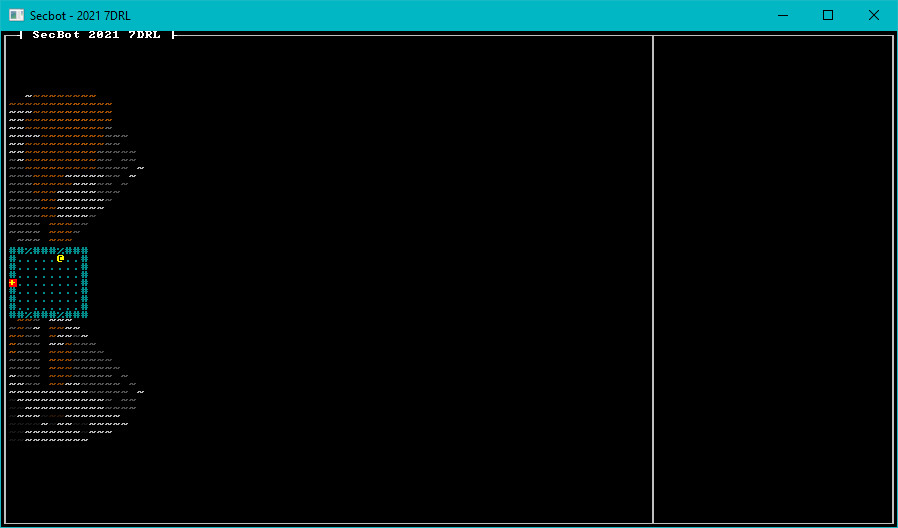This tutorial is free and open source, and all code uses the MIT license - so you are free to do with it as you like. My hope is that you will enjoy the tutorial, and make great games!
If you enjoy this and would like me to keep writing, please consider supporting my Patreon.
Walls, Windows and Field-of-View
Now that we have a nice landscape, intended to be viewed out of the window - lets add some walls, a window, and the ability to look through the window. We've already done the hard part for this, so it's relatively plain sailing.
Add some tile types
I went ahead and fleshed out a bunch of tile types. In map/tile.rs, the constructors look like this now:
#![allow(unused)] fn main() { use bracket_lib::prelude::*; #[derive(Clone)] pub struct Tile { pub glyph: FontCharType, pub color: ColorPair, pub blocked: bool, pub opaque: bool, } impl Tile { pub fn default() -> Self { Self { glyph: to_cp437('.'), color: ColorPair::new(GREY, BLACK), blocked: false, opaque: false, } } pub fn empty() -> Self { Self { glyph: to_cp437('#'), color: ColorPair::new(DARK_GRAY, BLACK), blocked: true, opaque: false, } } pub fn floor() -> Self { Self { glyph: to_cp437('.'), color: ColorPair::new(DARK_GRAY, BLACK), blocked: false, opaque: false, } } pub fn wall() -> Self { Self { glyph: to_cp437('#'), color: ColorPair::new(DARK_GRAY, BLACK), blocked: true, opaque: true, } } pub fn capsule_floor() -> Self { Self { glyph: to_cp437('.'), color: ColorPair::new(DARK_CYAN, BLACK), blocked: false, opaque: false, } } pub fn capsule_wall() -> Self { Self { glyph: to_cp437('#'), color: ColorPair::new(DARK_CYAN, BLACK), blocked: true, opaque: true, } } pub fn capsule_window() -> Self { Self { glyph: to_cp437('%'), color: ColorPair::new(DARK_CYAN, BLACK), blocked: true, opaque: false, } } pub fn game_over() -> Self { Self { glyph: to_cp437('+'), color: ColorPair::new(YELLOW, RED), blocked: false, opaque: false, } } pub fn alien_landscape(height: f32) -> Self { let fg = if height < 0.0 { if height < -0.25 { (40, 20, 0) } else { GRAY } } else { ( (height * 128.0) as u8 + 128, ((height * 128.0) as u8 + 128) / 2, 0, ) }; Self { glyph: to_cp437('~'), color: ColorPair::new(fg, BLACK), blocked: height <= -0.255, opaque: false, } } } }
Flesh out the Docking Capsule
Open map/layerbuilder/entrance.rs. Replace the add_docking_capsule function as follows:
#![allow(unused)] fn main() { fn add_docking_capsule(map: &mut Layer, ecs: &mut World) { const MIDDLE: usize = HEIGHT / 2; const TOP: usize = MIDDLE - 3; const BOTTOM: usize = MIDDLE + 3; const LEFT: usize = 1; const RIGHT: usize = 8; // Floor for y in TOP..=BOTTOM { for x in LEFT..=RIGHT { let idx = map.point2d_to_index(Point::new(x, y)); map.tiles[idx] = Tile::capsule_floor(); } } // Encasing Walls for x in LEFT - 1..=RIGHT + 1 { let idx = map.point2d_to_index(Point::new(x, TOP - 1)); map.tiles[idx] = Tile::capsule_wall(); let idx = map.point2d_to_index(Point::new(x, BOTTOM + 1)); map.tiles[idx] = Tile::capsule_wall(); } for y in TOP - 1..=BOTTOM + 1 { let idx = map.point2d_to_index(Point::new(LEFT - 1, y)); map.tiles[idx] = Tile::capsule_wall(); let idx = map.point2d_to_index(Point::new(RIGHT + 1, y)); map.tiles[idx] = Tile::capsule_wall(); } // Add some windows let x_middle = (LEFT + RIGHT) / 2; let idx = map.point2d_to_index(Point::new(x_middle - 2, TOP - 1)); map.tiles[idx] = Tile::capsule_window(); let idx = map.point2d_to_index(Point::new(x_middle - 2, BOTTOM + 1)); map.tiles[idx] = Tile::capsule_window(); let idx = map.point2d_to_index(Point::new(x_middle + 2, TOP - 1)); map.tiles[idx] = Tile::capsule_window(); let idx = map.point2d_to_index(Point::new(x_middle + 2, BOTTOM + 1)); map.tiles[idx] = Tile::capsule_window(); // Spawn the game exit add_game_exit(map, ecs, Point::new(LEFT - 1, MIDDLE)); map.starting_point = Point::new(LEFT + 1, MIDDLE); } }
There's a lot in this function, so I commented the sections. It draws the floor as it did previously, and then encases that region with walls. I added some windows (the window tile being blocked but not opaque - so you can't walk through it, but it doesn't block vision), and then call the existing game exit, door and starting point code.
Adding a Field-of-View
I didn't feel like reinventing any wheels, so I used bracket-lib's built-in field of view system. That's part of why I implemented the BaseMap and Algorithm2D traits when defining the map: so I wouldn't have to write a full recursive shadow-casting function from scratch. This is pretty much the same as the way Hands-on Rust implements FoV.
Map Memory
Open map/layer.rs. The definition of Layer is extended to include a list of visible and revealed tiles. (A "visible" tile is currently in view. A "revealed" tile is one we've seen at some point, so the player knows what's there):
#![allow(unused)] fn main() { pub struct Layer { pub tiles: Vec<Tile>, pub revealed: Vec<bool>, pub visible: Vec<bool>, pub starting_point: Point, } }
The new function needs to be expanded to set these vectors to be false, with an entry for each map tile:
#![allow(unused)] fn main() { pub fn new(depth: usize, ecs: &mut World) -> Self { let layer = match depth { 0 => build_entrance(ecs), _ => Self { tiles: vec![Tile::default(); TILES], starting_point: Point::new(WIDTH / 2, HEIGHT / 2), visible: vec![false; TILES], revealed: vec![false; TILES], }, }; layer } }
Add a new implemented function to clear the visible set (we'll do this each time we calculate field-of-view, so tiles don't remain visible from our previous position):
#![allow(unused)] fn main() { impl Layer { ... pub fn clear_visible(&mut self) { self.visible.iter_mut().for_each(|b| *b = false); } }
Add a FoV Component
Create a new file, src/components/fov.rs and add the following to it:
#![allow(unused)] fn main() { use std::collections::HashSet; use bracket_lib::prelude::Point; pub struct FieldOfView { pub radius: i32, pub visible_tiles: HashSet<Point> } }
Now add mod fov; pub use fov::*; to src/components/mod.rs to make the component available.
Adding FoV to the Player Entity
In main.rs, find the part where you push the player entity. Add a new FieldOfView component, making the player construction look like this:
#![allow(unused)] fn main() { // Spawn the player self.ecs.push(( Player {}, Position::with_pt(self.map.get_current().starting_point, 0), Glyph { glyph: to_cp437('@'), color: ColorPair::new(YELLOW, BLACK), }, Description("Everybody's favorite Bracket Corp SecBot".to_string()), FieldOfView{radius: 20, visible_tiles: HashSet::new()}, )); }
We're giving the player a very large view range. That will be useful later on, I promise. At the top of the file, add a line to include the HashSet type:
#![allow(unused)] fn main() { use std::collections::HashSet; }
Updating the Player Game Logic
Open game/player.rs. After the call to tile_triggers (and before returning new_state) add:
#![allow(unused)] fn main() { update_fov(&new_state, ecs, map); }
Now add an update_fov function to the module:
#![allow(unused)] fn main() { fn update_fov(new_state: &NewState, ecs: &mut World, map: &mut Map) { if *new_state != NewState::Wait { return; } let mut query = <(&Player, &Position, &mut FieldOfView)>::query(); query.for_each_mut(ecs, |(_, pos, fov)| { fov.visible_tiles = field_of_view_set(pos.pt, fov.radius, map.get_current()); let current_layer = map.get_current_mut(); current_layer.clear_visible(); fov.visible_tiles.iter().for_each(|pt| { let idx = current_layer.point2d_to_index(*pt); current_layer.revealed[idx] = true; current_layer.visible[idx] = true; }); }); } }
Once again, if we aren't waiting - we bail out. Then we query entities with a Player, Position and FieldOfView component (which should be one entity). We call field_of_view_set to build the visibility list, and store it in the FieldOfView component's visible_tiles list. We clear the existing visible list. Then we iterate the set, making every tile we can see both visible and revealed.
Render the FoV
Still in map/layer.rs, we amend the render function to not display tiles we have never seen - and grey out tiles we remember but can't currently see:
#![allow(unused)] fn main() { pub fn render(&self, ctx: &mut BTerm) { let mut y = 0; let mut idx = 0; while y < HEIGHT { for x in 0..WIDTH { if self.visible[idx] { let t = &self.tiles[idx]; ctx.set(x + 1, y + 1, t.color.fg, t.color.bg, t.glyph); } else if self.revealed[idx] { let t = &self.tiles[idx]; ctx.set(x + 1, y + 1, t.color.fg.to_greyscale(), t.color.bg, t.glyph); } idx += 1; } y += 1; } } }
Give it a Spin
If you run the program now, you can peek out of the windows.

You can find the source code for
hello_asteroidhere.
Up Next
Next, we're going to add some basic buildings to the mining colony.
